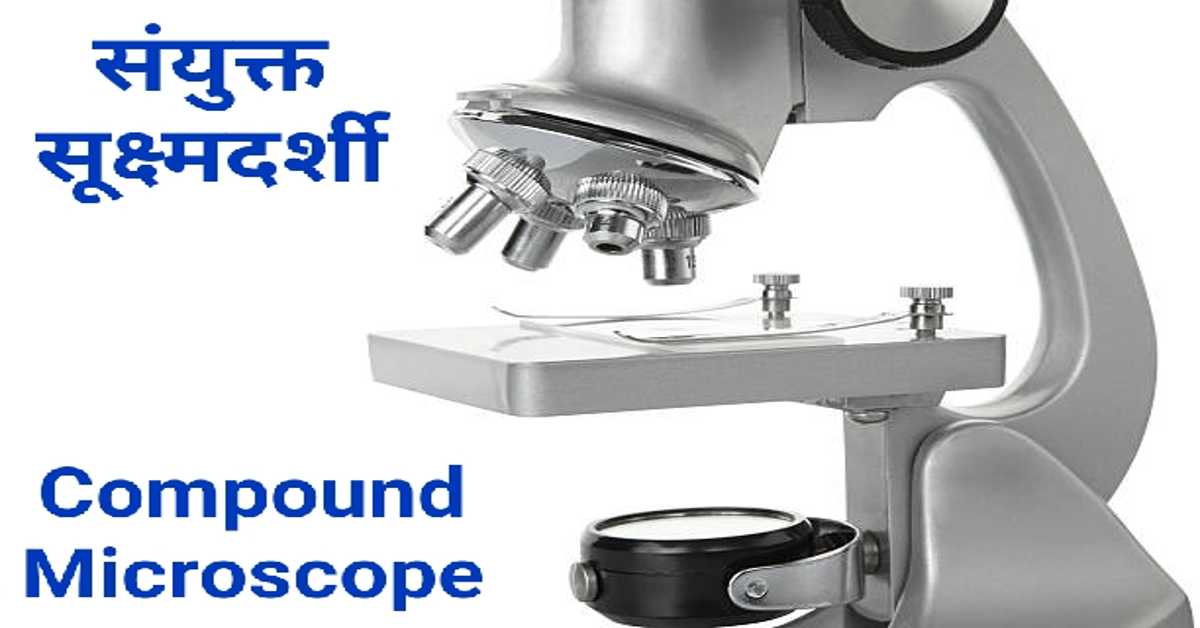
संयुक्त सूक्ष्मदर्शी की संरचना, रेखाचित्र और कार्यविधि | Compound Microscope
परिभाषा (Definition)
संयुक्त सूक्ष्मदर्शी दो उत्तल लेंसों के संयोग द्वारा आवर्धन प्राप्त करने की युक्ति है। इस प्रकाशीय यंत्र (संयुक्त सूक्ष्मदर्शी) के द्वारा सूक्ष्म कणों को स्पष्ट रूप से देखा जा सकता है।
Compound microscope is a device for obtaining magnification by combining two convex lenses. Fine particles can be seen clearly with this optical instrument (combined microscope).
भौतिक विज्ञान के इन 👇 प्रकरणों को भी पढ़ें। (Also read these 👇 episodes of Physics.)
सरल सूक्ष्मदर्शी का चित्र सहित वर्णन | Simple Microscope With Diagram
रेखाचित्र (Diagram)

भौतिक विज्ञान के इन 👇 प्रकरणों को भी पढ़ें। (Also read these 👇 episodes of Physics.)
सूक्ष्मदर्शी और दूरदर्शी क्या होते हैं? | What Are Microscopes And Telescopes?
संरचना (Structure)
संयुक्त सूक्ष्मदर्शी में एक खोखली नली होती है। इस नली के एक सिरे पर एक उत्तल लेंस L1 लगा रहता है। यह लेंस वस्तु की ओर रहता है। इसे अभिदृश्यक लेंस कहा जाता है। खोखली नली के दूसरे सिरे पर एक और खोखली नली लगी होती है। यह नली अभिदृश्यक वाली नली में दण्ड-चक्री प्रबन्ध द्वारा आगे-पीछे खिसकायी जा सकती है। इस नली में उत्तल लेंस L2 लगा होता है। इसे नेत्र लेंस कहा जाता है। नेत्र लेंस के सामने निश्चित दूरी पर क्रॉस तार लगा होता है। इस नली को नेत्रिका नली कहा जाता है। दण्ड-चक्री प्रबन्ध द्वारा नेत्रिका नली आगे-पीछे सरकाकर अभिदृश्यक लेंस व नेत्र लेंस के मध्य की दूरी को परिवर्तित किया जा सकता है। अभिदृश्यक लेंस की फोकस दूरी और द्वारक कम होते हैं। इनकी तुलना में नेत्र लेंस की फोकस दूरी और द्वारक थोड़े अधिक होते हैं। यदि अभिदृश्यक लेंस की फोकस दूरी f0 तथा नेत्र लेंस की फोकस दूरी fe हो, तो संयुक्त सूक्ष्मदर्शी की नली की लंबाई (f0 + fe) से अधिक होगी। नेत्र लेंस की फोकस दूरी, अभिदृश्यक लेंस की फोकस दूरी से अधिक होती है, किन्तु दोनों की फोकस दूरियों में अधिक अन्तर नहीं होता।
Compound microscope has a hollow tube. A convex lens L1 is fixed at one end of this tube. This lens remains towards the object. This is called the objective lens. Another hollow tube is attached at the other end of the hollow tube. This tube can be moved back and forth through the bar-wheel arrangement in the visible tube. A convex lens L2 is fitted in this tube. This is called the eye lens. A cross wire is placed at a fixed distance in front of the eye lens. This tube is called the ophthalmic tube. The distance between the objective lens and the eye lens can be changed by moving the eye tube back and forth through the bar-wheel arrangement. The focal length and aperture of the objective lens are small. In comparison, the focal length and aperture of the eye lens are slightly greater. If the focal length of the objective lens is f0 and the focal length of the eye lens is fe, then the length of the tube of the compound microscope (f0 + fe). The focal length of the eye lens is greater than the focal length of the objective lens, but there is not much difference between the two focal lengths.
भौतिक विज्ञान के इन 👇 प्रकरणों को भी पढ़ें। (Also read these 👇 episodes of Physics.)
प्रकाशीय यन्त्र क्या होते हैं? | What Are Optical Instruments?
कार्यविधि (Procedure)
मानलो अभिदृश्यक लेंस के सामने कोई वस्तु AB रखी हुई है। इस वस्तु का प्रतिबिम्ब A'B' नेत्र लेंस के सामने बनता है। यह प्रतिबिम्ब उल्टा, वास्तविक और आवर्धित बनता है। नेत्र लेंस की दूरी को इस प्रकार समंजित किया जाता है कि वह प्रतिबिम्ब उसके फोकस और प्रकाशीय केन्द्र के मध्य बने। इस प्रकार AB का प्रतिबिम्ब A'B' नेत्र लेंस के लिए वस्तु का कार्य करता है। नेत्र लेंस के द्वारा A'B' का प्रतिबिम्ब A"B" बनता है। यह प्रतिबिम्ब नेत्र लेंस से थोड़ी दूरी पर बनता है। यह प्रतिबिम्ब उल्टा और वास्तविक बनता है। यह प्रतिबिम्ब बहुत बड़ा बनता है। यदि प्रतिबिम्ब A'B' नेत्र लेंस के फोकस पर बने, तो अन्तिम प्रतिबिम्ब नेत्र लेंस से अनन्त दूरी पर बनता है। अतः संयुक्त सूक्ष्मदर्शी से किसी छोटी वस्तु का बहुत बड़ा प्रतिबिम्ब देखा जा सकता है।
Assume an object AB is placed in front of the objective lens. The image of this object is formed in front of the A'B' eye lens. This image becomes inverted, real and magnified. The distance of the eye lens is adjusted in such a way that the image is formed between its focus and the optical center. Thus the image A'B' of AB acts as the object for the lens of the eye. The image A"B" of A'B' is formed by the eye lens. This image is formed at a short distance from the eye lens. This image becomes inverted and real. This image becomes very large. If image A'B' is formed at the focus of the eye lens, then the final image is formed at infinite distance from the eye lens. Therefore, a very large image of a small object can be seen with a compound microscope.
भौतिक विज्ञान के इन 👇 प्रकरणों को भी पढ़ें। (Also read these 👇 episodes of Physics.)
आँखों की संरचना का सचित्र वर्णन | Pictorial Description Of Eye Structure
भौतिक विज्ञान के इन 👇 प्रकरणों को भी पढ़ें। (Also read these 👇 episodes of Physics.)
1. प्रकाश का अपवर्तन | सघन और विरल माध्यम || Refraction Of Light | Denser And Rarer Medium
2. स्नेल का नियम क्या है? | अपवर्तन के नियम || What Is Snell's Law? | Laws Of Refraction
3. निर्गत कोण क्या होता है? | What Is The Output Angle?
4. अपवर्तनांक किसे कहते हैं? | What Is The Refractive Index Called?
5. लेंस किसे कहते हैं? | उत्तल लेंस और अवतल लेंस || What Is Lens? | Convex Lens And Concave Lens
आशा है, उपरोक्त जानकारी उपयोगी एवं महत्वपूर्ण होगी।
(I hope the above information will be useful and important. )
Thank you.
R. F. Tembhre
(Teacher)
pragyaab.com




Comments